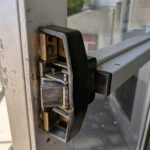Today’s Fixed-it Friday photo was sent in by Rick Turcotte of Horner Commercial Sales. A few questions for you…
a) This is a 4′-wide stairwell door. What’s wrong with this picture?
b) Is it a code issue if the door is serving a hospital unit that consists of patient rooms and support spaces?
c) Does the answer to “b” change depending on whether the International Building Code is being enforced or NFPA 101 – The Life Safety Code is being enforced?
I’m going to withold your comments for a while, and I’ll update this post late this afternoon after everyone has weighed in.
You need to login or register to bookmark/favorite this content.







Hello Lori, long time no post from me, I am doing good,
now the pic, I know whats going on here,
answer to A. the touchpad area is too short (has to be more then half the width of the door to meet the code)
B. I feel this is a code issue no matter if it’s a restaurant, hospital, apartment building, or school, it still holds more then 50 people at any given time and must comply with the codes of life/fire safety/egress and all areas requiring a panic exit use the same code, touchpad area must be more then half the width of the door.
C. I think the NFPA as well as IBC should enforce this one, as the fire codes are important matter it be here in the united states/Canada, in UAE, the UK or Hong Kong/China and therefor should not be changed between the 2 agencies governing the codes.
-Jess
Bad judge on measuring,
But actuating portion does not extend at least one half the door leaf width?
Do not have access to 101 right now , so not sure if there is a 101 problem
Also is it listed “fire exit hardware” since it is on a stairwell door
a – actuating portion of the device must be no less than half the width of the door. This one doesn’t appear to be half the width.
b – NFPA 101 2009 7.2.1.7.1 (1) does not give any exceptions to the actuating pad/bar width requirement.
c – IBC 2012 1008.1.10.1 2 does not give any exceptions to the actuating pad/bar width requirement either so no it does not make a difference if IBC or NFPA 101 is being enforced.
Most codes today, require one-half of the door width as the minimum active portion of an exit device. The active portion
refers to the part of the device that, when depressed, retracts or pulls back the latch. This part of the exit device is known as the touch bar. Looks like touch bar is less than half of door width.
While I am becoming more versed in code every day (self taught I might add) I’m going to say common sense would dictate that the panic bar be the entire width of the door.
The pushpad on the exit is too short.
It’s a l m o s t 1/2 the width………
The exit device push pad appears to be from a three foot device. Nice job on the mechanism case cover too!
Panic activator smaller then half door size.
A Looks like a 3′ device in a 4′ case.
B yes
C I don’t think so.
Push pad on panic too short.
By looking at the picture I feel the the touch=pad is quite short compared to the overall length of the panic device.
When inspecting a door I would not try to determine if that panic was required, but if it is on there at all the push bar should cover half the door width regardless of whose jurisdiction it is. Maybe I’m over simplifying, proper application of what ever hardware you are using is paramount to me.
Dave W
Does the 12″ push side, 18″ pull side rule apply here. If so, there’s an issue. Thoughts?
I don’t know anything about the layout, so I’m not sure of the specifics. The question has come up before about why maneuvering clearance for a wheelchair is needed for a stair door, but the accessibility standards don’t have a specific exception for stair doors and stairs can provide an area of refuge for someone using a wheelchair. I’ve run into several situations where an auto operator was proposed on a stair door because of a maneuvering clearance problem, but the issue with that is it’s a fire door so the operator has to be deactivated during a fire alarm, defeating the purpose.
Thanks, Ms. Lori …
My understanding of the 12/18 rule has to do with both wheelchair clearance but also allowing for someone fully ambulatory but strength-impaired to be able to lean the free hand/arm against the adjacent wall as leverage for pushing or pulling. Body weight can be used for pushing, hence the smaller space requirement. Positioning and bracing the hand/body/arm for pulling requires room for the user to ‘lean in’, hence the larger pull side clearance. Yes? No? Maybe?
It does not appear to be a fire rated device.
What makes you say that?